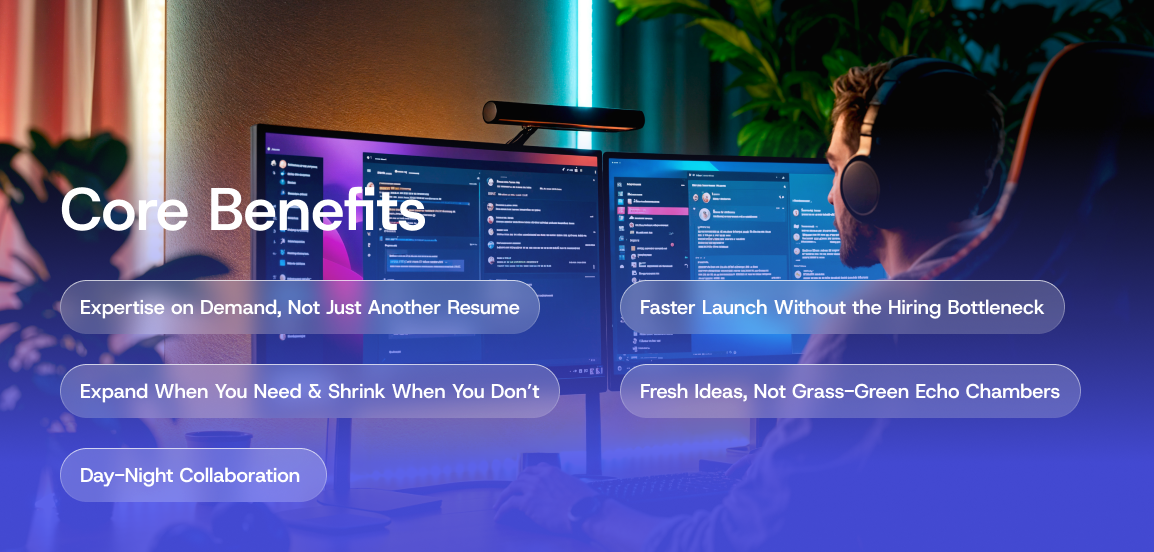Somewhere between the scramble of post-pandemic rebuilding and the current AI arms race, businesses started changing how they think about tech teams. The old way of renting out a shiny downtown office and packing it with full-time developers, started to feel outdated, even a little bloated. Today, you are just as likely to find a CTO running a lean, global team where the lead developer of an Outsourcing Python development company in Mumbai is working with the product manager sitting in Lisbon.
Outsourcing Python development services is no longer a trend anymore, it’s simply how smart companies build. And in 2025, it’s no longer just about cutting costs or filling talent gaps. It’s about flexibility, access to global expertise, and getting the right people on the job without the red tape. When a company needs a Django backend built yesterday, or wants a FastAPI endpoint wired into a serverless stack, they don’t wait around. They outsource. Quickly, strategically, and if they’ve done this before, a little more wisely than they did last time.
The rise of AI and data-heavy applications has only deepened Python’s dominance. From automating customer support flows with generative models to crunching massive datasets in finance, Python has quietly become the bloodstream of modern digital infrastructure. But demand is outpacing supply, and hiring from the leading Python software development company is expensive and often involves waiting in queue.
That’s where partnerships and real collaborations between businesses and remote Python specialists come into the picture. This is where both sides speak the same language, both technically and culturally. The ones who understand version control, write elegant documentation, and don’t flinch at unit testing. The kind of developers who tell you when you’re building something the hard way, and politely explain the easier route.
This guide is for founders, CTOs, product managers, and curious tech leads who want to get outsourcing right, not just to save money, but to build something that works. Something that lasts. We’ll walk through the strategies, red flags, and real stories.
When Outsourcing Python Development Makes and Doesn’t Make Sense
Outsourcing is often painted as either a cure-all or a risky gamble. Actually in most contexts it is beneficial while in some cases it may not be the right answer to fulfill skill gaps.
Outsourcing is particularly beneficial in the following scenarios:
- You’re exploring a new product direction and don’t want to staff up just yet.
- Your team is already stretched thin, and you need specialized expertise, say, for integrating with machine learning APIs or scraping complex datasets.
- You are operating in multiple time zones and need developers working while you sleep.
Another concern is when your product is still in flux, outsourcing cannot be an ideal choice. If your vision changes weekly, and you’re figuring it out as you go, onboarding an external team might slow you down. They will be waiting for direction while you’re still trying to define the path.
Core Benefits of Outsourcing Python Development in 2025

Outsourcing isn’t about sacrificing quality, it’s about choosing flexibility over rigidity, especially in today’s breakneck tech world.
Expertise on Demand, Not Just Another Resume
Year by year, Python has grown deeper. Whether it’s Django-heavy backends, FastAPI microservices, or machine‑learning toys using PyTorch, there’s a person somewhere whose day-to-day job is only this stuff. Working with them means you don’t rebuild the wheel, you just use advanced tools from day one.
Expand When You Need & Shrink When You Don’t
Hiring is expensive. Layoffs are messy. Say your roadmap targets a feature-heavy summer release. You don’t want to hire full-time devs just for three-month sprints, only to let them go afterward.
Outsourcing talents from a specialist Python development company lets you scale up during crunch time and scale down without guilt. It’s like renting extra hands when the shop gets busy, no long-term lease required.
Day-Night Collaboration
Sometimes time zone differences actually help in keeping the development running round the clock.
It’s like having a relay team, you pass the baton as you break for lunch, and come back to new code in the morning. No one’s working overnight, you’re just harnessing the clock differently.
Faster Launch Without the Hiring Bottleneck
Suppose you have got a board meeting in four weeks. You need a demo. The problem? Your hiring engine is stalled. Resumes trickle in. Interviews lag behind.
Outsourcing bypasses that. You can onboard a specialist who gets up to speed in days, not weeks. That prototype goes from pipe dream to polished, just in time for the pitch.
Fresh Ideas, Not Grass-Green Echo Chambers
Teams get comfortable, even too comfortable. They loop through the same libraries, patterns, and architectures. Introducing an external dev is like opening a window in a stale room. Suddenly, there’s talk of alternative approaches, newer frameworks, or faster tooling.
We had a situation where a long-standing internal app had performance issues. An outside dev suggested using Redis and asynchronous workers, cutting a batch process from 20 minutes to under a minute.
The Hidden Challenges of Outsourcing Python Development

There are several much talked-about advantages of outsourcing such as faster time to market, access to global talent pool, and development without hiring headaches. But outsourcing comes with its own challenges. Some of these challenges include missing deadlines, communication breakdown, and the toll of time zone mismatches.
Any seasoned product manager should expect and, more importantly, plan for these challenges.
Communication That Falls Apart at the Worst Time
You are in the middle of a critical sprint, things are moving fast, and suddenly your outsourced team goes dark for hours, or worse, for days. Not because they have vanished, but because no one clarified how often updates should happen, in what format, or over which tools.
To fix this you need to communicate early and rigorously, and this will prevent you from doing micromanagement at a later stage. Another important thing is to set the rules well in advance for how the collaboration should take place. Set predefined communication events like daily stand-ups, weekly demos, continuous or time-bound updates through Slack or Twilio. Lastly, you need to be ruthless about time zone transparency.
Misaligned Expectations Around Quality
The word “done” means different things to different teams. One developer’s “MVP-ready” is another’s half-baked prototype. This kind of misalignment can quietly derail a project.
Remember, instead of blaming developers, smart product teams define quality upfront.
Data Security and IP Concerns
It’s not just the Fortune 500 companies that worry about leaks and legal risk. Startups with sensitive user data or early product IP need to be cautious, too.
A leading Python development outsourcing company won’t flinch when you bring up NDAs, data handling policies, or version control hygiene. In fact, they’ll be relieved you’re serious about it.
Make sure contracts are airtight. That includes IP ownership, code delivery terms, and exit plans. And please, don’t skip the basics like secure Git workflows, encrypted communication, and region-compliant data handling.
These are normal pains in any project. The companies that succeed with Python development outsourcing are not the ones who avoid problems altogether, they are the ones who plan for them, spot them early, and respond quickly.
How to Choose the Right Python Development Outsourcing Partner in 2025
While you have options galore with tall claims and so-called list of credentials, without a deeper evaluation process you are open to risks of losing money on mediocre or incompetent developers. Here are some tried and tested ways to evaluate your would-be resources.
Start with Their Track Record & But Look Beyond the Logos
It’s great if an agency has worked with Fortune 500 companies. But don’t get blinded by it. What matters more is whether they’ve solved problems similar to yours. If you’re building a machine learning-driven recommendation engine, working with someone who’s built five e-commerce sites isn’t going to help much, even if they were beautiful.
Ask for real examples. Ask how they handled edge cases, bugs, pivots in scope. If they can talk through those things clearly, you’ve got a strong lead.
Vet Their Team, Not Just Their Sales Pitch
A lot of outsourcing firms have stellar salespeople, but you’re not hiring them. You’re hiring the developers behind the scenes. You should have the right to speak with at least a few of them, especially the ones who might actually touch your codebase.
Ask what frameworks they have worked in recently. How they handle technical debt. How they communicate with blockers. A quick 15-minute chat will tell you more than any glossy proposal ever could.
Test with a Small Project First
Think of it like dating. You don’t propose after the first coffee. Take time to evaluate the developers.
Start with a defined task, something small but meaningful. Maybe a feature that’s been sitting in your backlog forever. Such tests lay bare the quality of their code and their style of documentation.
Watch How They Handle Questions You Didn’t Ask
Remember, a great Python development outsourcing company partner sometimes will tell you things you didn’t think to ask.
Maybe they spot a performance bottleneck in your existing stack. Or they suggest a more scalable architecture before you even bring it up. It shows they’re not just building what you told them to. They’re thinking like product partners.
On the flip side, if all you get are yes-men who agree to everything without a single question, you have every reason to doubt.
Evaluate the Communication Skills
Are they able to discuss technical details and pros and cons in simple English? Do they document their work as they build, or do they just bring together all pull requests at the eleventh hour? How often do they update you, and how transparently?
You want some tempo to the way work gets shared, reviewed, and discussed. This is why evaluating these aspects is of critical importance. If communication is messy early on, it is bound to get worse later.
Don’t Just Compare Rates, Compare Value
Yes, budgets always matter. And it is sure that hourly rates in India or Eastern Europe are lower than in the U.S. But don’t fall into the trap of thinking that the cheapest bid is the best deal.
Dig Into Their Process
Any decent firm will tell you they use Agile, do sprint planning, and follow best practices. But don’t stop there.
Ask to sit in on one of their sprint reviews. Or look at how they write user stories and track bugs.
Hiring Models in 2025: Freelancers, Agencies, or Dedicated Teams?
Outsourcing Python development services in 2025 isn’t just about finding talents who can code, it’s about choosing a setup that genuinely fits how you work, what you’re building, and where you’re headed. And while the buzz around tech hiring models hasn’t really changed, how people actually use them has evolved quite a bit.
Let’s talk real-world, no buzzwords, no generic lists, just straight insights.
Freelancers: When One Good Developer Can Be Enough
Freelancers have become the go-to for lightweight, short-term work. Think startups working out of co-working spaces, or even product managers who just need to validate an idea quickly without going all in. Sites like Upwork or Toptal make it easy, though great freelancers still tend to come through referrals.
You are the one keeping the ship on course. You’ll manage timelines, communication, testing, everything. And if your freelancer picks up another gig mid-way? That’s your stress to carry.
Development Agencies
Agencies often bring a project manager into the mix, which helps if you’re not a technical founder. But there’s always a balance to strike, because once you go the agency route, you might have to give up some creative control.
And yes, it’s costlier, but that price includes peace of mind, at least in most cases.
Dedicated Remote Teams: Like Hiring In-House, Without the Office Drama
Let’s say you are scaling. Your MVP worked, users are growing, and now you need stability. Freelancers feel too temporary. Agencies feel too distant. What you really need is a team that feels like it’s your team.
That’s where dedicated remote teams come in. This model lets you hire full-time Python developers, or even an entire squad, who work exclusively on your project. Usually, they’re hired through a service provider, but the daily communication and roadmap come from you. It’s the closest thing to in-house development, without renting office space or dealing with payroll across continents.

How to Vet Python Developers in 2025
Outsourcing from a Python software development company might sound like it starts with a contract and ends with a deadline, but the truth is, everything hinges on the people you bring on board. Especially when it comes to Python developers, the ones writing the logic that holds your product together.
In 2025, resumes still matter, sure. Portfolios matter more. But what you really need to look for goes beyond the code itself.
Let’s talk through how smart companies are actually vetting Python talent right now—not hypotheticals, just grounded observations from the trenches.
Forget the Buzzwords. Look for How They Think.
Every decent developer knows how to use Python libraries like Pandas or Flask. That’s the baseline now. What separates a good hire from a so-so one is how they approach a problem when there isn’t an obvious answer.
Give them a challenge that isn’t copy-paste from Stack Overflow. Something messy. Maybe ask them to improve the performance of a function without giving much context. Or walk through how they’d refactor legacy code that’s built like a spaghetti bowl.
You are not trying to stump them, you are trying to see how they pause, how they reason, and whether they start with “why” before rushing to “how.”
Portfolios Are Everything. But Only If They Are Real.
A GitHub link is great. But has it been updated recently? Does it show contributions to actual repositories, or just forks of tutorials?
You want to find signs of ownership. Look for commit messages that tell a story. Look for patterns, are they someone who obsessively documents their work? Do they fix bugs? Do they contribute to open-source projects even if they’re not glamorous?
Talk Projects, Not Just Tools
Some candidates will list ten frameworks on their CV and hope one of them is the one you use. But tools can be learned. What you want to know is what they did with those tools.
Did they build an internal tool that saved a team five hours a week? Did they rewrite a monolith app into microservices without breaking production? The leaks nobody catches until now”? Evaluate any solution that they built and get into its details.
A Quick Word on Culture Fit
Culture fit is often misunderstood. It doesn’t mean hiring people who think just like you. It means hiring someone who’ll respect your process and challenge it when it’s wrong.
If your team runs sprints every Monday but your dev thinks roadmapping is a waste of time, that’s friction. If your company’s values lean toward over-communication and your dev disappears for days, that’s misalignment.
One startup founder I interviewed makes every final-stage candidate join a “team lunch” call. Not to quiz them. Just to see how they engage when it’s not technical. Some candidates open up. Others don’t say a word. That tells you something.
Don’t Skip Reference Check
You’d be amazed how many companies skip reference checks entirely in the rush to hire. But they’re one of the most revealing parts of the process if you ask the right questions.
You’re not looking for perfection. You are looking for consistency and the ability to handle the learning curve.
Red Flags to Watch Out For
Let’s be honest: Not every candidate who says they know Python actually does.
Some red flags in 2025 still look a lot like the ones from a decade ago:
- Overuse of vague phrases like “helped optimize code” without backing examples.
- Inability to explain projects beyond surface-level buzzwords.
- Quick-to-anger responses when questioned on decision-making.
- Inconsistent GitHub histories with sudden spikes in activity (often a sign of portfolio polishing before interviews).
What Python Development Actually Costs in 2025?
Ask ten businesses what they paid for Python development services in 2025, and you will probably hear ten different numbers. One company may have onboarded a developer for under $20 an hour, while another paid six figures for a full-stack rebuild.
Let’s go deeper into cost estimation for outsourcing across regions, key cost factors, and cost of different hiring models.
First Things First: Why the Range Is So Wide
Outsourcing in 2025 isn’t what it used to be. The global market matured. Developers are no longer just coders, they’re specialists in scalable systems, AI integration, or real-time applications. Rates reflect that evolution.
At one end of the spectrum, you will find junior developers or part-time freelancers charging around $15 to $25 an hour, often from South Asia or Southeast Asia. On the other end? Niche-experienced backend engineers in Germany or San Francisco charging north of $150 an hour. Both might be “Python developers,” but the roles, and outcomes, couldn’t be more different.
A Realistic Breakdown by Region
Let’s look at how location still plays a major role in pricing, even as remote work levels the field in many ways:
- South Asia (India, Pakistan, Bangladesh): $18 – $40/hour
- Southeast Asia (Vietnam, Philippines): $20 – $45/hour
- Eastern Europe (Ukraine, Romania, Poland): $30 – $75/hour
- Latin America (Argentina, Brazil, Colombia): $25 – $65/hour
- Western Europe (Germany, France, UK): $60 – $120/hour
- North America & Australia: $85 – $180/hour
These aren’t “fixed” numbers, of course, think of them as the going rate ranges for vetted developers with a few years of real experience.
One founder I recently spoke with put it well: “We paid more for someone in Warsaw than we would’ve for a dev in Vietnam, but we weren’t buying code, we were buying speed and context.” In his case, time zone overlap and strong Django experience reduced project timelines by 30%, justifying the cost.
What Are You Actually Paying For?
You’re not buying lines of code. You’re investing in the problem-solving ability, clarity of communication, and the quality of the solution. Here’s what often drives pricing behind the scenes:
- Experience & Seniority: A junior dev with two years of work and GitHub enthusiasm is a different investment than a Python architect who’s scaled SaaS platforms.
- Stack Complexity: If your project uses plain Python scripting, expect lower rates. Add Django, Docker, FastAPI, or AWS integrations, and the price per hour climbs, because the skills are deeper and more valuable.
- Project Depth: A script that parses a CSV file doesn’t cost the same as a full-featured analytics dashboard with machine learning. Complexity shapes time, which shapes cost.
- Team Structure: Are you hiring just a developer, or a dev with a QA tester, UI/UX designer, DevOps support, and a project manager? That ecosystem costs more, but likely saves you time and risk.
- Timezone Compatibility: Overlapping hours and strong English communication often command a premium. But if meetings don’t get lost in translation or delay cycles, the ROI is clear.
How Companies Are Paying: Hourly, Monthly, or Fixed?
There’s no universal billing model, but each has its place. Let’s decode the three most common ones:
Hourly Contracts
If you only need bug fixing, small changes or enhancements, or don’t know how far the changes can go, this can be the befitting model.
The cost of hiring in hourly contracts ranges from $25 to $150/hour.
Small You’re paying for active work only, but without solid scope boundaries, costs can quietly spiral.
Monthly Contracts
This model is ideal for long-term product development or in projects where you need full-time dedicated resources.
Monthly cost range can vary from $2,500 to $12,000 per developer, depending on experience and region.
The key advantages of this model include continuity of the same resources for a longer period, faster onboarding, and committed output from the developers.
Fixed-Price Projects
Fixed price model is appropriate for building any app with a clear scope. It is also ideal for MVPs.
The fixed cost ranges from $7,000 to $25,000 for basic MVPs, and $100,000 or above for large enterprise-grade solutions.
Predictable and precise budget is the biggest advantage of this model. This is why it is important to fix your priorities well in advance when going with this pricing model.
Wrapping Up
Outsourcing Python development is not about finding the cheapest coders or ticking priority boxes on a checklist. It’s actually way messier than that and more revealing as well. It’s about people, trust, timing, and knowing when to lean in or walk away. Some companies nail it by hiring one solid freelancer; others grow faster with entire remote teams they have never met in person. The real takeaway is not to chase rates or resumes. Instead ask yourself, who do I actually want to develop my solution? The answer won’t always be obvious, but if you pay attention, it usually gives you the right direction.
Table of Contents
- When Outsourcing Python Development Makes and Doesn’t Make Sense
- Core Benefits of Outsourcing Python Development in 2025
- The Hidden Challenges of Outsourcing Python Development
- How to Choose the Right Python Development Outsourcing Partner in 2025
- Hiring Models in 2025: Freelancers, Agencies, or Dedicated Teams?
- How to Vet Python Developers in 2025
- Wrapping Up










